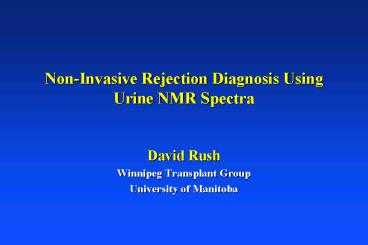NonInvasive Rejection Diagnosis Using Urine NMR Spectra - PowerPoint PPT Presentation
1 / 20
Title:
NonInvasive Rejection Diagnosis Using Urine NMR Spectra
Description:
the clinical manifestations of acute rejection have changed with present-day immmunosuppression. ... Roxanne Deslauriers. Raymond Somorjai. Miriam Glogowski. Tony Shaw ... – PowerPoint PPT presentation
Number of Views:49
Avg rating:3.0/5.0
Title: NonInvasive Rejection Diagnosis Using Urine NMR Spectra
1
Non-Invasive Rejection Diagnosis Using Urine NMR
Spectra
- David Rush
- Winnipeg Transplant Group
- University of Manitoba
2
Immune Monitoring for Rejection of Kidney
Transplants
- the clinical manifestations of acute rejection
have changed with present-day immmunosuppression.
There are usually no local symptoms, and the
abnormalities are typically limited to insidious,
low-level dysfunction of the graft... - systematic and repeated urinalyses performed
in the absence of substantial changes in graft
function may provide a unique opportunity to
detect subclinical episodes of rejection that may
culminate in chronic rejection - Soulillou (NEJM (2001) 3441006)
- Editorial comment to Li et al (NEJM (2001)
344945)
3
Surveillance for Acute RejectionStandard of
Practice Serum Creatinine
Treatment
Diagnostic Threshold
Cr
Baseline Function
Inflammation
Strengths Samples the Entire Graft Rapid
Turnaround Time Non-invasive Inexpensive Wid
ely Available
Weaknesses Lacks Specificity (Need a Biopsy to
Diagnose Rejection) Lacks Sensitivity
4
Immune Surveillance Goal is to Develop a
Biomarker in the Blood or Urine
Anti-HLA Antibody
GRAFT
CTL
Capillary
Renal Tubule
Urine
Blood
5
Immune Surveillance Probe for the Inflammatory
Programs of Acute Rejection
IL-2
Th
M?
TNFa
IFNg
IL-4 IL-10
anti-HLA Ab
B
6
Immune Surveillance Blood and Urine Biomarkers
- Blood
- PBMC RT-PCR CTL gene transcripts ( Fas, Granzyme,
Perforin ) - Vasconcellos et al (Transplantation 199866562)
- Urine
- Flow cytometry to detect CD3 and HLA-DR on urine
cells - Roberti et al (Transplantation 199559495)
- RT-PCR CTL gene transcripts ( Granzyme, Perforin
) - Li et al (NEJM 2001344945)
7
Immune Surveillance Blood or Urine Biomarker
Development
- Limitations to the development of biomarker
- Tarnished Gold Standard (i.e. classification
error of the biopsy) - Lack of Specificity of any single biomarker
- Biomarkers should distinguish Acute Rejection vs.
Drug toxicity, Infection, ATN - Specificity could be improved by developing a
- Donor antigen specific assay
- Requires donor antigen source (e.g. donor spleen
cells) - Profile based on all components ( known / unknown
) in a blood or urine sample - Requires strategies able to profile all
components in a sample
8
Immune Surveillance Donor Antigen Specific
Biomarkers
- Require Donor Cells for Analysis
- Flow Cross-match (anti-HLA Ab)
- OMalley et al (ITS 1998 Abstr 1370)
- ELISPOT Cytokine Assay
- Heeger et al (J Immunol (1999) 1632267)
- DTH Assay (Tolerance Assay)
- VanBuskirk et al (J Clin Invest (2000) 106145)
9
Immune Surveillance Strategies to Profile all
Components in the Blood or Urine
10
Immune Surveillance Can Early Allograft
Inflammation be Detected by a Distinct Urine MR
Spectral Profile?
- Study Design
- Gold Standard Protocol Biopsy (months 1, 2, 3
and 6) - Urine Collected at time of Protocol Biopsy and
stored at -80C - Study Population
- Normal Urine Spectra
- Transplant Patients with Normal Histology by
Protocol Biopsy - Rejection Urine Spectra
- Transplant Patients with Acute Rejection by
Protocol Biopsy
11
Developing an MR Biomarker Makes No Assumption as
to What Target is Important
Normal Spectra
Rejection Spectra
Classifier Rejection
12
INFORMATICS Rate-Limiting Step is Analysis of
the Spectral Profile
- 1H MR spectra
- 0.5-4.5 and 6.5-9.5 ppm
- 1690 data points / spectra
- Multivariate classification strategy
- Optimal region selector (data reduction)
- Bootstrap cross-validation
- Linear Discriminant Analysis (LDA) classifier
13
1H MR Biomarkers Developed from the Urine Spectra
Correctly Identify Allograft Histology
- Normal vs Rejection Histology
14
A Biomarker for Rejection Must Be Specific
Weeks Post-Transplant
Creatinine (mmol/L)
Simulect Neoral MMF Prednisone
15
The Biomarker for Rejection May Precede the
Histologic Diagnosis of Rejection
Weeks Post-Transplant
Simulect Neoral MMF Prednisone
Creatinine (mmol/L)
Steroids
16
The Biomarker for Rejection can Persist After
Allograft Function Returns to Baseline
Weeks Post-Transplant
Creatinine (mmol/L)
Neoral MMF Prednisone
Steroids
17
Urine 1H MR BiomarkerPrecedes and Persists
after the Diagnosis of Rejection
- 46 patients had 154 protocol biopsies
- 31/154 biopsies had diagnosis of Acute Rejection
- 24/31 had a urine sample prior to the biopsy
- 18/24 the urine MR classifier for rejection was
present 1-2 weeks prior to the biopsy. - 15/24 had urine samples collected after the
biopsy - 9/15 the urine MR classifier for rejection
disappeared within 4 weeks and was confirmed by
repeat protocol biopsy. - 4/15 the urine MR classifier for rejection
persisted at for 4 weeks and a a repeat
protocol biopsy confirmed the persistence of
rejection. - 2/15 have rejection classifier at last follow up
(not biopsied)
18
Case Presentation from Yesterday
Weeks Post-Transplant
Creatinine (mmol/L)
Simulect Neoral MMF Prednisone
Steroids
Steroids
14
N
i1t0
i2t2 (SC)
i2t2 (SC)
19
Conclusions
- Subclinical renal allograft rejection appears to
have a distinct urine 1H MR spectrum - Resolution of subclinical rejection may correlate
with the disappearance of the spectrum and vice
versa - Repeated, frequent urine spectral analysis may
establish whether there is a link between
subclinical acute rejection and the development
of chronic rejection - Monitoring of urine 1H MR spectra may assist in
drug withdrawal and tolerance protocols
20
Collaborators
UNIVERSITY OF MANITOBA
Peter Nickerson John Jeffery Sylvia Dancea
NRC INSTITUTE FOR BIODIAGNOSTICS
Roxanne Deslauriers Raymond Somorjai Miriam
Glogowski Tony Shaw































